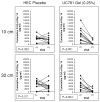Rectal microbicide development
- PMID: 23612991
- PMCID: PMC4245014
- DOI: 10.1007/82_2013_325
Rectal microbicide development
Abstract
The last few years have seen important progress in demonstrating the efficacy of oral pre-exposure prophylaxis, vaginal microbicides, and treatment as prevention as effective strategies for reducing the risk of acquiring or transmitting HIV infection. There has also been significant progress in the development of rectal microbicides. Preclinical non-human primate studies have demonstrated that antiretroviral microbicides can provide significant protection from rectal challenge with SIV or SHIV. Recent Phase 1 rectal microbicide studies have characterized the safety, acceptability, compartmental pharmacokinetics (PK), and pharmacodynamics (PD) of both UC781 and tenofovir gels. The tenofovir gel formulation used in vaginal studies was not well tolerated in the rectum and newer rectal-specific formulations have been developed and evaluated in Phase 1 studies. The PK/PD data generated in these Phase 1 studies may reduce the risk of advancing ineffective candidate rectal microbicides into late stage development. Tenofovir gel is currently poised to move into Phase 2 evaluation and it is possible that a Phase 2B/3 effectiveness study with this product could be initiated in the next 2-3 years.
Figures


Similar articles
-
A Phase 1 Randomized, Open Label, Rectal Safety, Acceptability, Pharmacokinetic, and Pharmacodynamic Study of Three Formulations of Tenofovir 1% Gel (the CHARM-01 Study).PLoS One. 2015 May 5;10(5):e0125363. doi: 10.1371/journal.pone.0125363. eCollection 2015. PLoS One. 2015. PMID: 25942472 Free PMC article. Clinical Trial.
-
Rectal microbicide development.Curr Opin HIV AIDS. 2012 Nov;7(6):526-33. doi: 10.1097/COH.0b013e3283582bc2. Curr Opin HIV AIDS. 2012. PMID: 23032732 Free PMC article. Review.
-
Prevention of SIV rectal transmission and priming of T cell responses in macaques after local pre-exposure application of tenofovir gel.PLoS Med. 2008 Aug 5;5(8):e157; discussion e157. doi: 10.1371/journal.pmed.0050157. PLoS Med. 2008. PMID: 18684007 Free PMC article.
-
Microbicides for prevention of HIV infection: clinical efficacy trials.Curr Top Microbiol Immunol. 2014;383:97-115. doi: 10.1007/82_2013_330. Curr Top Microbiol Immunol. 2014. PMID: 23695725 Review.
-
Clinical development of microbicides for the prevention of HIV infection.Curr Pharm Des. 2004;10(3):315-36. doi: 10.2174/1381612043386374. Curr Pharm Des. 2004. PMID: 14754390 Review.
Cited by
-
Development, Characterization and In Vivo Pharmacokinetic Assessment of Rectal Suppositories Containing Combination Antiretroviral Drugs for HIV Prevention.Pharmaceutics. 2021 Jul 21;13(8):1110. doi: 10.3390/pharmaceutics13081110. Pharmaceutics. 2021. PMID: 34452070 Free PMC article.
-
An Open-Label Pharmacokinetic and Pharmacodynamic Assessment of Tenofovir Gel and Oral Emtricitabine/Tenofovir Disoproxil Fumarate.AIDS Res Hum Retroviruses. 2022 Apr;38(4):279-287. doi: 10.1089/AID.2021.0115. Epub 2021 Oct 29. AIDS Res Hum Retroviruses. 2022. PMID: 34541872 Free PMC article. Clinical Trial.
-
A Phase 1 Randomized, Open Label, Rectal Safety, Acceptability, Pharmacokinetic, and Pharmacodynamic Study of Three Formulations of Tenofovir 1% Gel (the CHARM-01 Study).PLoS One. 2015 May 5;10(5):e0125363. doi: 10.1371/journal.pone.0125363. eCollection 2015. PLoS One. 2015. PMID: 25942472 Free PMC article. Clinical Trial.
-
Prevalence and types of rectal douches used for anal intercourse: results from an international survey.BMC Infect Dis. 2014 Feb 21;14:95. doi: 10.1186/1471-2334-14-95. BMC Infect Dis. 2014. PMID: 24555695 Free PMC article.
-
HIV epidemics among transgender women.Curr Opin HIV AIDS. 2014 Mar;9(2):168-73. doi: 10.1097/COH.0000000000000030. Curr Opin HIV AIDS. 2014. PMID: 24322537 Free PMC article. Review.
References
-
- Abdool KQ, Abdool Karim SS, Frohlich JA, Grobler AC, Baxter C, Mansoor LE, Kharsany AB, Sibeko S, Mlisana KP, Omar Z, Gengiah TN, Maarschalk S, Arulappan N, Mlotshwa M, Morris L, Taylor D. Effectiveness and safety of tenofovir gel, an antiretroviral microbicide, for the prevention of HIV infection in women. Science. 2010;329:1168–1174. - PMC - PubMed
-
- Abner SR, Guenthner PC, Guarner J, Hancock KA, Cummins JE, Jr, Fink A, Gilmore GT, Staley C, Ward A, Ali O, Binderow S, Cohen S, Grohskopf LA, Paxton L, Hart CE, Dezzutti CS. A human colorectal explant culture to evaluate topical microbicides for the prevention of HIV infection. J Infect Dis. 2005;192:1545–1556. - PubMed
-
- Agashe H, Hu M, Rohan L. Formulation and delivery of microbicides. Curr HIV Res. 2012;10:88–96. - PubMed
-
- Altman D, Aggleton P, Williams M, Kong T, Reddy V, Harrad D, Reis T, Parker R. Men who have sex with men: stigma and discrimination. Lancet. 2012;380:439–445. - PubMed
Publication types
MeSH terms
Substances
Grants and funding
LinkOut - more resources
Full Text Sources
Other Literature Sources
Medical

